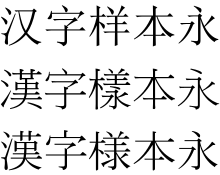List of CJK fonts
This is a list of notable CJK fonts (computer fonts which contain a large range of Chinese/Japanese/Korean characters). These fonts are primarily sorted by their typeface, the main classes being "with serif", "without serif" and "script". In this article, the two first classes are named Ming and sans-serif (gothic) while the "script" is further divided into several Chinese script styles.
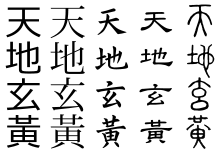
The first four characters of Thousand Character Classic in different typeface styles, script styles and type styles. From left to right: sans-serif (gothic), Ming, regular script, clerical script and seal script
The fonts are then sorted by their target writing system:[Note 1]
- Chinese: Chinese character
- Japanese: kanji, hiragana and katakana
- Korean: Hangul, hanja, etc.
- Vietnamese: for the Nom script formerly used
- Zhuang: for Sawndip
- Pan-Unicode: intended to globally support the majority of Unicode's characters, and not specifically designed for one or a few writing systems (note that Pan-Unicode font ≠ Unicode font[Note 2])
- Pan-CJK: intended to support the majority of Chinese/Japanese/Korean characters, and not specifically designed for any one of these writing systems
[F] means this font is free and open-source software (FOSS); [F] means it was formerly seen as FOSS but has been involved in a legal controversy.
Ming (Song)
Pan-Unicode
Pan-CJK
- [F] Hanazono Mincho (花園明朝)[1] Two ttf fonts HanaMinA (Japanese 花園明朝A) for BMP and HanaMinB (Japanese 花園明朝B) for SIP – covers all CJK, CJK Compatibility, CJK-Ext.A, CJK-Ext.B, CJK-Ext.C, CJK-Ext.D, CJK-Ext.E, and CJK-Ext.F. Dual licensed under its own Hanazono Font License or SIL Open Font License. This font has issues in LaTeX if rotated with
\setCJKmainfont[Vertical=RotatedGlyphs]{HANAMINA.TTF}, as required for traditional writing: some characters aren't displayed after rotating, while they work without rotation. - [F] Sazanami-Hanazono Mincho[2] – a full CJK and Latin-1 truetype font resulting from merge of Sazanami Mincho and Hanazono fonts.
- [F] Source Han Serif / Noto Serif CJK – created by Adobe and Google, released under SIL Open Font License v.1.1 in April 2017.[3]
- The font package TH-Tshyn consists of three fonts, TH-Tshyn-P0, TH-Tshyn-P1 and TH-Tshyn-P2. Version 2.1.0 offers complete coverage of all Unicode CJK characters up to CJK Unified Ideographs Extension F introduced in June 2017 with Unicode version 10.0.[4]
Pan-Chinese
- [F] AR PL UMing (or AR PL ShanHeiSun Uni, AR PL 上海宋) – Arphic Public Licensed free font, one of CJKUnifonts project font, included with a number of Linux distributions. It is a merged version of two typefaces in Arphic PL Fonts released to free software by Arphic foundry.
Traditional Chinese
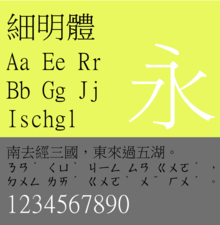
Sample of MingLiU(細明體), monospaced font for Latin characters.
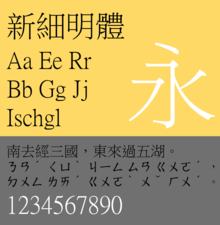
Sample of PMingLiU(新細明體), proportional font for Latin characters.
- DLCMingMedium (華康中明體), DLCMingBold (華康粗明體) – the font family from which Windows 3.0's default Traditional Chinese font 'Ming Light' is derived.
- MingLiU (細明體) – default interface typeface for Windows 3.0 to Windows XP, derived from DynaLab's DLCMing typeface.

mingliu.ttc) was distributed with the Traditional Chinese version of Windows 95 to Windows 98, all regional versions of Windows 2000 to Windows 8.1, Traditional Chinese version of Windows 10, PMingLiU Update Pack (新細明體更新套件), Traditional Chinese Font Pack for Internet Explorer 3, Microsoft Global IME 5.02 (Traditional Chinese), Office XP Tool: Traditional Chinese Language Pack, Traditional Chinese supplemental fonts for Windows 10. - PMingLiU (
mingliu.ttc, 新細明體) – distributed by Microsoft with the Traditional Chinese version of Windows 98 operating system, all regional versions of Windows 2000 to Windows 8.1, and the Traditional Chinese version of Windows 10. The Latin characters in this font is proportional. - MingLiU-ExtB (
mingliub.ttc,細明體-ExtB), PMingLiU-ExtB (新細明體-ExtB) – distributed with PMingLiU Update Pack (新細明體更新套件), Windows Vista. - MingLiU_HKSCS, MingLiU_HKSCS-ExtB (
mingliu.ttc,mingliub.ttc) – distributed with Windows Vista. - LiSong Pro Light (儷宋 Pro) – distributed with Mac OS 9 and Mac OS X 10.3–10.4.
- Apple LiSung Light (蘋果儷細宋) – distributed with Mac OS 9 and Mac OS X 10.2–10.4.
- [F] I.Ming (I.明體) – Derived from IPAex Minchō font, availably at Keshilu (刻石錄) and GitHub.[5][6] Licensed under IPA font licence.
Simplified Chinese
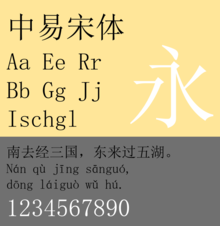
Sample of SimSun (中易宋体), monospaced font for Latin characters.
- MS Song (MS宋体) – distributed with Simplified Chinese Font Pack for Internet Explorer 3, Microsoft Global IME 5.02 (Simplified Chinese), Office XP Tool: Simplified Chinese Language Pack.
- SimSun (
simsun.ttc, 中易宋体 or simply 宋体) – default interface typeface for Windows 95 to Windows XP, distributed with the Chinese versions of Windows 95 to Windows 98, all regions of Windows XP, Microsoft Office 2000. The Latin characters in this font is monospaced. The difference between this font ans NSimSun (below) is that NSimSun is labelled monospaced in thepostandOS/2table while SimSun did not.[7][8] - NSimSun (
simsun.ttc, 新宋体) – distributed with all regions of Windows XP, Microsoft Office 2000. The Latin characters in this font is monospaced. - SimSun-18030 (宋体-18030), NSimSun-18030 (新宋体-18030) – distributed with the Simplified Chinese version of Windows XP, or as GB18030 Support Package to Windows 2000 or higher.
- SimSun (Founder Extended) (宋体–方正超大字符集) – distributed with the Simplified Chinese version of Microsoft Office XP, Simplified Chinese version of Windows, or Microsoft Office Proofing Tools (XP and 2003).
- SimSun-ExtA (宋體ExtA, Sun-ExtA)
- SimSun-ExtB (
simsunb.ttf, 宋體ExtB. Sun-ExtB) – distributed with Windows Vista. - Song – distributed with OS X 10.2–10.4.
- STSong (华文宋体) – distributed with MS Office 2000 and XP, OS X 10.2–10.4. The Jiangsu-based foundry, Changzhou SinoType Technology (常州华文印刷新技术), made a series of 30,000+-character fonts for Microsoft and Macintosh between 1998 and 2004 that all begin with "ST" (华文).
- STZhongsong (华文中宋) – distributed with MS Office 2000 and XP. A medium-boldness version of STSong made in 1991 and updated in 1998.
- [F] WenQuanYi Bitmap Song (文泉驿点阵宋体) – a raster typeface under GNU GPL.
[F][F] Fandol Song. In two weights. Licensed under GPL with the font exception. There is debate on whether the font is FOSS as the author may have revoked the license. [9]
Japanese
- [F] IPAex Minchō – Part of IPA font series developed by Information-technology Promotion Agency, Japan. Released from here.[10] Licensed under IPA font licence.
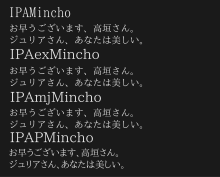 Sample of IPAMinchō typeface.
Sample of IPAMinchō typeface. - [F] IPAmj Minchō – Part of IPA font series developed by Information-technology Promotion Agency, Japan. Released from here.[11] Licensed under IPA font licence.
- MS Mincho (MS 明朝) – distributed with the Japanese version of Windows 3.1 or later, some versions of Internet Explorer 3 Japanese Font Pack, all regions in Windows XP, Microsoft Office v.X to 2004.
- MS PMincho (MS P明朝) – distributed in the Japanese version of Windows 95 or later, all regions in Windows XP, Microsoft Office 2004.
- [F] Kochi Mincho (東風明朝) – free typeface included with a number of Linux distributions. Released in the public domain. Originally based on the Watanabe (渡邊フォント) typeface, then reissued based on the Wadalab outlines for legal reasons.
- Hiragino Minchō Pro W3 (ヒラギノ明朝Pro W3), Hiragino Minchō Pro W6 (ヒラギノ明朝Pro W6) – included in Mac OS X. It covers almost all of the Adobe Japan 1–5 glyph collection.
- Heisei Minchō (平成明朝) – developed by the Japanese Standards Association (JSA) as a standard typeface for information devices in 1989. It has rather straight edges so that low-resolution printers can output characters with less aliasing. It is distributed by various typeface vendors licensed by the JSA.
- Ryūbundō Minchō (RyūMin, リュウミン) of the Morisawa foundry.
- Kozuka Minchō (小塚明朝), designed by Kozuka Masahiko (also the creator of the sans-serif typeface Shin Gothic or Shingo).
- [F] Sazanami Mincho (さざなみ明朝).[12] The last version dates from 2004.
Korean
- Batang (바탕), BatangChe (바탕체), Gungsuh (궁서), GungsuhChe (궁서체) – distributed by Microsoft with its Windows operating system. -Che suffix means monospace font.
- AppleMyungjo (애플명조) – default Korean font on Apple Mac OS, Mac OS X, and iOS. Fully supports Unicode from Mac OS X 10.5 Leopard.
- [F] UnBatang (은바탕), UnGungsuh (은궁서) – included in most Linux distributions. Initially made by Un Koanghui (은광희) as a set of type 1 typefaces to use with Korean LaTeX. Later they were converted to opentype typefaces by Park Won-gyu (박원규). UnBatang also has a version with opentype GSUB/GPOS tables to support archaic Hangul with Hangul Conjoining Jamos.
- [F] Baekmuk Batang (백묵 바탕) – included in most Linux distributions, made by Kim Jeong-hwan (김정환) and released under a liberal license.
- Seoul Hangang (서울한강체) – distributed by Seoul Metropolitan Government as its official Ming typeface. Special font for vertical writing included.
- [F] Nanum Myeongjo (나눔명조) – one of Nanum-series fonts, distributed by Naver, under Open Font License.
- [F] Hamchorom Batang (함초롬바탕) – developed by Hancom, supporting Unicode from 1.0 to 5.0 and Hangul Jamo Extended A/B.[13]
- [F] Jieubsida Batang (지읍시다바탕) – Korean-language, Ming style offshoot of the Tsukurimashou meta-family, built using METAFONT and distributed under GPL.[14]
Vietnamese
- Nôm Na Tống Light – created by the Vietnamese Nôm Preservation Foundation. It is based on characters found in Thiền Tông Bản Hạnh (The Origin of Buddhist Meditation, 1933) by Thanh Tu Thich.[15]
- [F]Han Nom Font Set – covers Radicals Supplements, CJK, CJK Ext. A, CJK Ext. B; GPL licensed
- Han-Nom Minh 1.30 by UBPSHNVN contains 34,736 characters with 34,737 glyphs.
- Han-Nom Ming 1.10 by UBPSHNVN contains 34,079 characters with 34,082 glyphs.
Zhuang
- [F] Sawndip – in addition to 20k CJK characters in AR PL UMing on which it is based upon it also has over 8 thousand CJK characters used to write Sawndip not in Unicode in PUA plane 16. Distributed under 1999 Arphic Public License.
Sans-serif
Pan-Unicode
- Arial Unicode MS – distributed with Microsoft Office 2000, XP, 2004.
- [F] Droid Sans Fallback – created by Ascender Corporation for use by Google's mobile operating system Android, licensed under Apache License 2.
Pan-CJK
- [F] Source Han Sans / Noto Sans CJK – created by Adobe and Google (together with Changzhou SinoType Technology, Iwata Corporation, and Sandoll Communication), released under Apache License 2 on July 15, 2014.[16][17] Since September 29, 2015, all Noto fonts are licensed under the SIL Open Font License rather than the Apache licence.[18]
Chinese
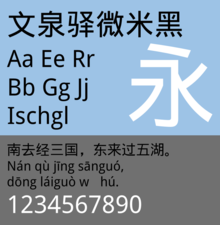
Sample of WenQuanYi Micro Hei (文泉驿微米黑)
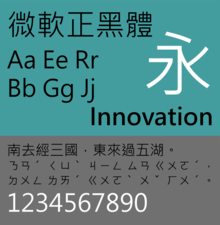
Sample of Microsoft JhengHei (微軟正黑體)
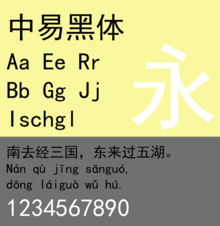
Sample of SimHei (中易雅黑), monospaced font for Latin characters.
- [F] WenQuanYi Zen Hei (文泉驿正黑) – freely available and licensed under GPL v2.0 with font embedding exceptions, including over 36,000 glyphs in total, among which 20,300 are Chinese characters.
- [F] WenQuanYi Micro Hei (文泉驿微米黑) – freely available and dual licensed under GPL v3 or Apache License v2, based on Droid Sans Fallback.
[F][F] Fandol Hei. In two weights. Licensed under GPL with the font exception. There is debate on whether the font is FOSS as the author may have revoked the license. [9]- PingFang SC & PingFang TC & PingFang HK (苹方-简 & 蘋方-繁 & 蘋方-港) – available in OS X 10.11 El Capitan.
- Heiti SC & Heiti TC (黑体-简 & 黑體-繁) – available in OS X 10.6 Snow Leopard.
- Hiragino Sans GB (冬青黑体简体中文 & ヒラギノ角ゴ 簡体中文) – available in OS X 10.6 Snow Leopard.
- STHeiti (华文黑体) – available in OS X 10.2 Jaguar and later. Another font by Changzhou SinoType Technology made in 2002.
- STHeiti Light [STXihei] (华文细黑) – available in OS X 10.2 Jaguar and later, Microsoft Office 2000 and XP. A thinner version of STHeiti Regular.
- LiHei Pro Medium (儷黑 Pro) – available in Mac OS X 10.3 Panther and later.
- Apple LiGothic Medium (蘋果儷中黑) – available in Mac OS 9 and OS X 10.2 Jaguar and later.
- Microsoft JhengHei (
msjh.ttf,msjhbd.ttf, 微軟正黑體) – distributed with Windows Vista as default interface font. Designed by China Type Design Limited. - Microsoft YaHei (
msyh.ttf,微软雅黑) – distributed with Windows Vista as default interface font. Designed by Founder Type. - MS Hei (MS黑体) – distributed with Microsoft Global IME 5.02 (Simplified Chinese), Office XP Tool: Simplified Chinese Language Pack.
- MHei (蒙纳黑體) – Owned by Monotype.
- SimHei (
simhei.ttf, 中易黑体 or simply 黑体) – distributed with Windows 2000, all regions of Windows XP. - DengXian (等线) – distributed with Simplified Chinese version of Microsoft Office 2016 and Windows 10.
Japanese
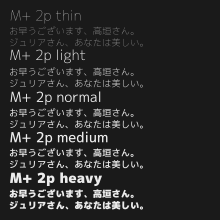
Sample of M+ OUTLINE FONTS typeface.
- [F] IPA Gothic – Part of IPA font series developed by Information-technology Promotion Agency, Japan. Released from here.[19] Licensed under IPA font licence.
- Meiryo (メイリオ) – distributed with Windows Vista as default interface font.
- [F] Mona Font – a free font that is included with a number of Linux distributions. Released in the public domain.
- [F] M+ OUTLINE FONTS – Japanese font families. Released under an open-source licence.
- [F]? VL Gothic (VLゴシック) – a font originating from Vine Linux. It includes glyphs derived from M+ FONTS and Sazanami Gothic font, thus the licenses of these two fonts are both regarded.
- MS Gothic (MS ゴシック) – default system font distributed with the Japanese version of Windows 3.1 or later, all regions of Windows 2000 to Windows 8.1, Japanese version of Windows 10, Microsoft Office v.X to 2004, Japanese font pack for Internet Explorer 3, Microsoft Global IME 5.02 (Japanese), Office XP Tool: Japanese Language Pack, Japanese supplemental fonts for Windows 10.
- MS PGothic (MS Pゴシック) – distributed with the Japanese version of Windows 95 and later, all regions of Windows XP, Microsoft Office 2004.
- MS UI Gothic – Default interface font from Windows 98 to Windows XP. Distributed with the Japanese version of Windows 98 and later, all regions in Windows XP.
- Yu Gothic (游ゴシック) – In non-Japanese versions of Windows 10, MS Gothic is no longer included by default, so this is the default font for Japanese text.
- Osaka – default system font on Classic Mac OS.
- Hiragino Kaku Gothic (ヒラギノ角ゴ) and Hiragino Maru Gothic (ヒラギノ丸ゴ) – default Japanese system font on Mac OS X.
- Kozuka Gothic (小塚ゴシック) – typeface family provided by new versions of Adobe Illustrator.
- GothicBBB-Medium – used by Adobe as one of the two CJK fonts in many examples in its documentation.
[F]Kochi Gothic (東風ゴシック) – Originally named Watanabe font (渡邊フォント), is a font formerly considered free that is included with a number of Linux distributions. The development of the font stopped when it was discovered that Watanabe font – which Kochi Gothic based on – was copied from the TypeBank Mincho-M font, developed by TypeBank and Design Laboratory, Hitachi, Ltd.[20][21][22][F]Sazanami Gothic (さざなみゴシック)[23] – Also a font formerly considered free and included with a number of Linux distributions.[24]
Korean
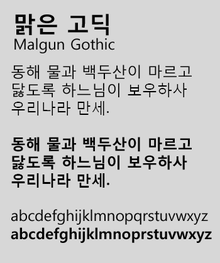
Sample of Malgun Gothic typeface.
- AppleGothic (애플고딕) – default Korean font on Apple Mac OS 9 to Mac OS X 10.7 Lion and iOS 1 to 5.0. Fully supports Unicode from Mac OS X 10.5 Leopard.
- Dotum (돋움), DotumChe (돋움체), Gulim (굴림) – included with the Korean version of Microsoft Windows, all regions of Windows XP to Windows 8.1, and the Korean version of Windows 10.
- GulimChe (굴림체) – Distributed with all regions of Windows 2000 to Windows 8.1, Korean version of Windows 10, Office XP Tool: Korean Language Pack, Korean supplemental fonts for Windows 10.
- Malgun Gothic (맑은 고딕) – distributed with Windows Vista as default interface font.
- New Gulim (새굴림), Gulim Old Hangul Jamo – distributed with Old Korean support tools for Microsoft Word 2000, Office XP Tool: Korean Language Pack, Microsoft Office 2003.
- Apple SD Gothic Neo (애플 SD 산돌고딕 Neo) – default Korean font on Apple Mac OS X 10.8 Mountain Lion and iOS 5.1.
- [F] UnDotum (은돋움) – one of Un-series fonts initially derived from Korean LaTeX fonts with the same name. freely available and licensed under GPL. included in a number of Linux distributions.
- [F] UnShinmun (은신문)– one of Un-series fonts initially derived from the Korean LaTeX fonts.
- [F] Baekmuk Gulim (백묵굴림) – freely available and included in a number of Linux distributions.
- Seoul Namsan (서울남산체) – distributed by Seoul Metropolitan Government as its official sans-serif typeface.
- [F] Nanum Gothic (나눔고딕) – one of Nanum-series fonts, distributed by Naver, under Open Font License.
- [F] Hamchorom Dotum (함초롬돋움) – developed by Hancom, supporting Unicode from 1.0 to 5.0 and Hangul Jamo Extended A/B.[13]
- [F] Jieubsida Dodum (지읍시다돋움) – Korean-language, sans serif offshoot of the Tsukurimashou meta-family, built using METAFONT and distributed under GPL.[14]
Vietnamese
- Han-Nom Gothic 1.30 by UBPSHNVN contains 35,733 characters with 36,306 glyphs.
Regular script
.svg.png)
Sample of Regular script typeface. Shown above are the characters 漢字 (Pinyin: Hànzì), meaning "Chinese characters".
Chinese
- KaiU or DFKai-SB (
kaiu.ttf, 標楷體) – designed by DynaComware, distributed by Microsoft with Chinese version of Windows 95 or higher. Shipped with OS X until Yosemite (disabled by default, placed in deprecated folder). - SimKai (
simkai.ttf, 中易楷体 or 楷体_GB2312) – distributed with Chinese version of Windows. - STKaiti (华文楷体) – distributed with Simplified Chinese version of Microsoft Office. Created in 2002 by Changzhou SinoType.
- [F] AR PL UKai (AR PL 中楷) – Arphic Public Licensed free font, one of CJKUnifonts project font, included in some Linux distributions, derived from Arphic PL Fonts.
- Kai – included in Simplified Chinese version of macOS. Made by the foundry Shanghai Ikarus between 1993–95.
- BiauKai – included in Traditional Chinese version of Mac OS.
- FZKaiS-Extended and FZKaiS-Extended(SIP) for simplified Chinese as well as FZKaiT-Extended and FZKaiT-Extended(SIP) for traditional Chinese. Huge fonts with 28,928 glyphs in the basic BMP fonts plus another 54,328 in the SIP fonts for both traditional and simplified Chinese. Created in 2006 by Founder of Beijing University (北大方正). In 2012 Founder released an updated version FZNewKai (方正新楷体)[25]
[F][F] Fandol Kai. Simplified Chinese font released under GPL with the font exception. There is debate on whether the font is FOSS as the author may have revoked the license. [9]- [F] I.Ngaan (I.顏體), derived from a Yan styled typeface by Wang Hanzong (王漢宗), availably at Keshilu (刻石錄).[26] Licensed under GPL 2.0 and later.
- [F] TW-Kai, TW-Kai-Ext-B and TW-Kai-Plus (全字庫正楷體) – from the Ministry of Education of Taiwan (教育部).[27][28] Includes more than 100,000 traditional and simplified characters (including Japanese shinjitai characters) in Taiwanese style, covering CNS 11643 (TW-Kai covers the characters mapped to the Basic Multilingual Plane, TW-Kai-Ext-B covers the characters mapped to CJK Unified Ideographs Extension B, TW-Kai-Plus covers Private Use Area mapped CNS characters).
- [F] Free HK Kai (自由香港楷書) – designed by Free Hong Kong Font (自由香港字型) project, based on TW-Kai, and List of Glyphs of Commonly Used Characters (常用字字形表) by Education Bureau of Hong Kong SAR, licensed under CC-BY 4.0 International license.[29]
Vietnamese
- Han-Nom Kai 1.00 by UBPSHNVN contains 28,147 characters with 28,145 glyphs.
Clerical script
Chinese
- SimLi (中易隶书 or 隶书) – distributed with the Chinese version of Microsoft Office.
Korean
- [F] UnYetgul (은옛글)– one of Un-series fonts initially derived from the Korean LaTeX fonts.
Imitation Song

Traditional Chinese character of "Han" in Imitation Song typeface.
Chinese
- FangSong (
simfang.ttf, 中易仿宋 or simply 仿宋) – distributed with the Chinese version of Microsoft Windows. - STFangsong (华文仿宋) – formerly distributed with Mac 10.4. Created in 2002 by Changzhou SinoType.
[F][F] Fandol Fang. Simplified Chinese font released under GPL with the font exception. There is debate on whether the font is FOSS as the author may have revoked the license. [9]
Other fonts or projects
Pan-Unicode
- [F] GNU Unifont – a GPLed bitmap font that covers the Unicode Basic Multilingual Plane.
- Code2000
Chinese
- SimYou (幼圆) – round font style, distributed with Chinese version of Microsoft Office.
[F][F] HanWang Series (王漢宗字体, 42 fonts) – released by Wang Hanzong (王漢宗), a professor at National Taiwan University, and licensed under GPL. Wang involved in copyright infringement with Arphic Technology for the fonts in 2005. Justfont, a CJK webfont service provider, provides 10 fonts from HanWang Series which appear safe from infringement claims.[30][F][F] cwTeX Chinese fonts (5 fonts) – GPLed, includes: cwTeX 仿宋體 (Imitation Song), cwTeX 圓體 (round font), cwTeX 明體 (Ming), cwTeX 楷書 (Regular script) and cwTeX 粗黑體 (Bold Sans-serif), the Bold Sans-serif has been involved in copyright infringement with Arphic Technology.- [F] Arphic PL Fonts (文鼎自由字型, 4 fonts) – includes AR PL KaitiM Big5 (文鼎 PL 中楷), AR PL Mingti2L Big5 (文鼎 PL 細上海宋), AR PL SungtiL GB (文鼎 PL 簡報宋) and AR PL KaitiM GB (文鼎 PL 簡中楷), released by Arphic Technology and licensed under the company's Arphic Public License. The CJKUnifonts project was derived from Arphic PL Fonts.
- AR PL MingU20-L (文鼎 PL 明體) and AR PL BaoSong2GBK (文鼎 PL 報宋), also released by Arphic Technology, but licensed under a new license which explicitly restrict distribution of the original or modified font to "only for non-profit purpose".
- [F] WenQuanYi Unibit – another bitmap monospaced font in the GPLed WenQuanYi font project.
- Series of the fonts by SinoType (Chinese: 华文; pinyin: Huá Wén; full name: 中国常州华文印刷新技术有限公司). e.g. HuaWen Xingkai (华文行楷), HuaWen CaiYun (华文彩云). Distributed with Microsoft Office.
- Series of the fonts by Founder Group (方正; Fāng Zhèng). e.g. FangZheng ShuTi (方正舒体), FangZheng QiTi (方正启体). Distributed with Microsoft Office.
- Series of the fonts by Han Yi (汉仪; Hàn Yí; full name: 北京汉仪科印信息技术有限公司). e.g. HanYi XueJun (汉仪雪君体)
- Series of the fonts by DynaLab (華康; Huá Kāng). e.g. HuaKang ShaoNu (華康少女體), HuaKang WuaWua (華康娃娃體).
- Series of the fonts by Arphic Technology (文鼎科技; Wén Dǐng Kējì).
- Shuowen Jiezi True Type Font(說文解字True Type字型) – most/all of the characters are small seal script. It is based on annotated Shuowen Jiezi and other sources.
- [F] I.PenCrane (I.鋼筆鶴體), derived from a handwriting styled typeface by Wang Hanzong (王漢宗), available at Keshilu (刻石錄).[31] Licensed under GPL 2.0 and later.
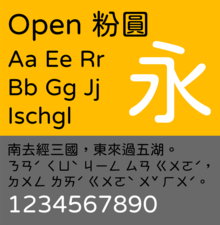
Sample of Open Huninn (Open 粉圓)
- [F] Open Huninn (Open 粉圓), rounded font style, derived from MOTOYA Kosugi Maru font. This is a free open-sourced Traditional Chinese font made by Justfont, a Taiwan font foundry.
Japanese
- Mojikyō (文字鏡)
- Y.OzFontN
- [F] Kanji Stroke Order Font (漢字の筆順のフォント)
- [F] Choumei (Kanji Stroke Order Font with the stroke numbers omitted)
Korean
- [F] UnGungseo (은궁서) – one of Un-series fonts initially derived from Korean LaTeX fonts, calligraphy styles.
- [F] Nanum Pen / Nanum Brush (나눔 손글씨) – one of Nanum-series fonts, distributed by Naver, under Open Font License.
- [F] Jieubsida Sun-Moon (지읍시다선문) – Korean-language, "felt marker style" offshoot of the Tsukurimashou meta-family, built using METAFONT and distributed under GPL.[14]
gollark: Wolf Mall???
gollark: Esy.
gollark: Patchinated.
gollark: Er. Oops.
gollark: Er, you need to include the filename.
See also
- Calligraphy
- Chinese input methods for computers
- Free software Unicode typefaces
- Japanese input methods
- Keyboard layout
- Korean language and computers
- List of typefaces
- Unicode typeface
Notes
- A font targeted to a writing system usually still contains glyphs in the other writing systems.
- If a Unicode font (font containing a wide range of Unicode's characters) is targeted to one or a few writing systems, it will not be listed as a "pan-Unicode font" (font intended to globally support a wide range of Unicode's characters)
References
- http://fonts.jp/hanazono/
- "Archived copy". Archived from the original on 2013-02-21. Retrieved 2012-12-15.CS1 maint: archived copy as title (link)
- "Noto Serif CJK is here!". Google Developers Blog. Retrieved 4 April 2017.
- More information on this and related font packages is available at the download page at http://yedict.com/download/.
- 造字:開源字型_i.明體 [刻石錄]
- ichitenfont/I.Ming: I.Ming ( I.明體 / 一點明朝體 / 一點明體 )
- "宋体(Simsun)和新宋体(NSimsun)的区别_c#_学习是为了探索这个世界的本质-CSDN博客". blog.csdn.net. Retrieved 28 May 2020.
- "中易宋体(SimSun)和新宋体(NSimSun)的区别是什么? - 知乎". www.zhihu.com. Retrieved 28 May 2020.
|first1=missing|last1=(help) - "【诈尸+吐槽】令人哭笑不得的「破产黑体」,暴露你乎某些「资深设计师」的真实水平". 知乎专栏 (in Chinese).
- "Archived copy". Archived from the original on 2010-08-23. Retrieved 2013-03-31.CS1 maint: archived copy as title (link)
- http://mojikiban.ipa.go.jp/1300.html
- Author page Archived 2018-07-05 at the Wayback Machine (in Japanese), deprecated ttf-sazanami-mincho Debian package
- http://www.hancom.co.kr/downLoad.downView.do?targetRow=1&seqno=3136&mcd_save=005
- http://sourceforge.jp/projects/tsukurimashou/releases/
- (in Vietnamese) "Quy trình Nôm Na: Giúp đọc Nôm và Hán Việt và chữ Nôm trên mạng", Tạp chí Nghiên cứu và Thảo luận, 5 July 2005.
- http://googledevelopers.blogspot.com/2014/07/noto-cjk-font-that-is-complete.html
- http://blog.typekit.com/2014/07/15/introducing-source-han-sans/
- https://www.google.com/get/noto/updates/
- http://ossiedia.ipa.go.jp/ipafont/index.html#en
- "About unauthorized copy of 32-dot bitmap font". Hiroki KANOU. June 27, 2003. Archived from the original on 19 August 2011. Retrieved 20 September 2011.
- "CID/OpenType conversion kit for Kochi Mincho/Kochi Gothic". June 18, 2003. Archived from the original on 19 August 2011. Retrieved 20 September 2011.
- フォントの権利侵害について (in Japanese). Hitachi Printing Solutions, Ltd. 29 Sep 2003. Archived from the original on August 5, 2004. Retrieved 20 September 2011.
- Author page Archived 2018-07-05 at the Wayback Machine (in Japanese)
- Deprecated ttf-sazanami-gothic Debian package
- http://foundertype.com/index.php/FontInfo/index.html?id=290
- 造字:開源字型_i.顏體 [刻石錄]
- https://data.gov.tw/license
- https://data.gov.tw/dataset/5961
- https://freehkfonts.opensource.hk/download
- justfont. "線上中文字型列表". Retrieved 2016-10-10.
- 造字:開源字型_i.顏體 [刻石錄]
Further reading
- Lunde, Ken (2009). CJKV Information Processing. O'Reilly. pp. 633–634. ISBN 978-0-596-51447-1.
External links
- "Fonts and supported products". Microsoft.
- "Fonts supplied with Windows and Mac OS X, by script". r12a.github.io.
- East Asian Unicode fonts for Windows computers
- TTF Korean fonts download
- List of free Simplified Chinese fonts
- List of free Traditional Chinese fonts
- List of free Japanese fonts
- List of free Korean fonts
- Free Chinese Font
- Free Japanese Font
- Free Korean Fonts
- Arphic Public License: a free font, licensed by Arphic Technology
- (in Chinese) 免费中文字体
- (in Chinese) 適用於 GNU/Linux 的字型
- Japanese Fonts on OSDN
- CJKV Fonts on ArchWiki
This article is issued from Wikipedia. The text is licensed under Creative Commons - Attribution - Sharealike. Additional terms may apply for the media files.
